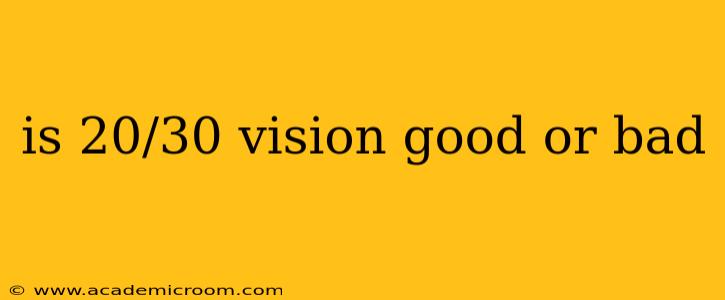Visual acuity, often expressed as a fraction like 20/30, is a measure of how clearly you can see at a specific distance. Understanding what your visual acuity means is crucial for making informed decisions about your eye health. So, is 20/30 vision good or bad? Let's dive in.
What Does 20/30 Vision Mean?
The fraction 20/30 means that at 20 feet, you can see what a person with perfect (20/20) vision can see at 30 feet. In simpler terms, you need to be closer to an object to see it as clearly as someone with perfect vision. While not considered legally blind, it's not perfect vision either.
Is 20/30 Vision Considered Good?
Generally, 20/30 vision is considered within the normal range, though not the sharpest. Many people with 20/30 vision live perfectly normal lives without significant visual impairment. They can usually drive, read, and participate in most activities without difficulty. However, it's still considered mildly impaired vision.
What Activities Might Be More Challenging With 20/30 Vision?
While 20/30 vision allows for most daily activities, some tasks might be more challenging:
- Driving at night: Reduced light conditions can exacerbate the slight visual impairment, making night driving slightly more difficult.
- Reading small print: Reading fine print, such as instructions or small text on a screen, might require more effort or a magnifying glass.
- Participating in certain sports: Some sports requiring high visual acuity, like professional archery or certain precision shooting sports, may be more difficult.
Can 20/30 Vision Be Corrected?
Yes, 20/30 vision is often correctable with eyeglasses, contact lenses, or refractive surgery like LASIK. A comprehensive eye exam by an ophthalmologist or optometrist can determine the cause of your reduced visual acuity and recommend the best course of correction.
What Causes 20/30 Vision?
Several factors can contribute to 20/30 vision, including:
- Refractive errors: Myopia (nearsightedness), hyperopia (farsightedness), and astigmatism are common refractive errors that can blur vision and lead to 20/30 or lower acuity.
- Age-related changes: As we age, our eyes may naturally change, leading to a decrease in visual acuity.
- Underlying eye conditions: In some cases, 20/30 vision might be a symptom of an underlying eye condition like cataracts or macular degeneration.
How Often Should I Get My Eyes Checked?
Regular eye exams are crucial for maintaining good eye health. The frequency of eye exams depends on factors like age, overall health, and family history. However, most eye care professionals recommend getting your eyes checked at least once every one to two years.
When Should I See an Eye Doctor About My 20/30 Vision?
While 20/30 vision isn't necessarily an emergency, it's essential to schedule an appointment with an eye doctor if:
- Your vision has suddenly worsened.
- You experience any new eye discomfort or changes in your vision.
- You have a family history of eye disease.
- You notice any floaters or flashes of light.
In conclusion, while 20/30 vision is not perfect vision, it's generally considered acceptable and correctable. Regular eye exams are key to maintaining healthy vision and addressing any potential issues. Don't hesitate to consult an eye care professional if you have concerns about your vision.
